By: Amanda Wiegert, LMHC, NCC
Have you ever seen the acronym EMDR and wondered what it stands for? Maybe this is your first time seeing those four letters put together. Either way, I’d like to help explain what EMDR is and how it can help you.
What is EMDR?
When we experience trauma, this event overwhelms our brain. We are unable to utilize our natural coping mechanisms. This means our brains then store those memories in an unhealthy way. The memory becomes “frozen” in such a way that we are unable to process the trauma. When our brains do not process a traumatic event, we are left with residual thoughts, feelings, and emotions. These are then triggered by similar events that happen later in our lives.
Although the past trauma may have happened years ago, our brain and body do not forget the fear, sadness, anger, or pain that we felt during the original trauma. This cycle will continue every time we experience a traumatic event until the original trauma is reprocessed and stored appropriately in the brain.
Experts created Eye Movement Desensitization Reprocessing (EMDR) therapy based on the idea that our brains have the ability to heal themselves following a deeply disturbing experience. EMDR uses bilateral stimulation similar to REM sleep to help the brain reprocess those traumatic or disturbing experiences.
You make these eye movements by simply following your therapist’s fingers back and forth across a visual field or sometimes your therapist may utilize a buzzer or a light bar. With these repeated sets of eye movements, the goal is for the memory to become less intense and painful as well as to decrease symptoms of the trauma (ie. anxiety, fear, depression, anger, etc).
EMDR can be effective in treating:
- Post-traumatic stress disorder (PTSD)
- Physical, sexual, and emotional abuse
- Anxiety
- Grief
- Phobias
- Addictions
- Low self-esteem
- Physical pain, phantom pain, and other medical conditions
Common myths about EMDR:
EMDR is a form of hypnosis.
EMDR differs from hypnosis in that during an EMDR session you remain in control, alert, and wide awake throughout the process. You are able to stop the processing at any time and you are encouraged to be present and aware of what you are thinking and feeling throughout the session.
EMDR is a new therapy.
Francine Shapiro developed EMDR more than 25 years ago in 1987. The first research studies on EMDR therapy started in 1989. It was after these studies that people quickly discovered that EMDR was going to be the up and coming treatment for PTSD. It has since evolved into a treatment that is used to treat many mental health and physical conditions.
EMDR will work in one session.
EMDR can be a very effective short-term treatment in many cases. However, it can also be necessary to use EMDR for an extended period of time depending on the person and the type of trauma. No two people are going to respond to EMDR in the same way. Because of this, it is important to be open minded about the length of time you need to utilize EMDR before seeing results.
How can EMDR help me?
EMDR can help to reprocess the disturbing or painful memories that we are left with following a traumatic experience. While EMDR will not get rid of the memory, it can assist in unblocking the memory networks in the brain so that you can begin the healing process.
Through healing, you can begin to develop healthier ways of dealing with the thoughts, feelings, and emotions that have come as a result of the trauma. You can also work with your therapist to create future templates for how to handle distressing or uncomfortable situations that arise in the future.
Everyone will experience something traumatic or disturbing at some point. It is important to recognize when that trauma impacts multiple areas of your life. EMDR can help reprocess those memories so that your brain stores them in a healthier way. Then you can greatly reduce the anxiety, depression, anger, fear, or other emotions that you may be feeling as a result of the trauma.
Many research studies have been conducted and have concluded that EMDR is an effective treatment method when utilized by a trained EMDR therapist. It is important that you take the steps necessary to regain control of your life. Your trauma does not have to cause pain, distress, and unpleasant feelings for the rest of your life.
If you would like to speak with Amanda to get more information about EMDR or to schedule an appointment, please contact Life Counseling Solutions at (407) 622-1770. Amanda also offers free 15-minute phone consultations to answer any questions that you may have.
 About the Author: Amanda is passionate about helping people navigate all stages of life. She believes great healing can emerge from trauma and challenges if we allow ourselves to be open to learning and exploring new ways of dealing with difficult life experiences. Read more about Amanda.
About the Author: Amanda is passionate about helping people navigate all stages of life. She believes great healing can emerge from trauma and challenges if we allow ourselves to be open to learning and exploring new ways of dealing with difficult life experiences. Read more about Amanda.






